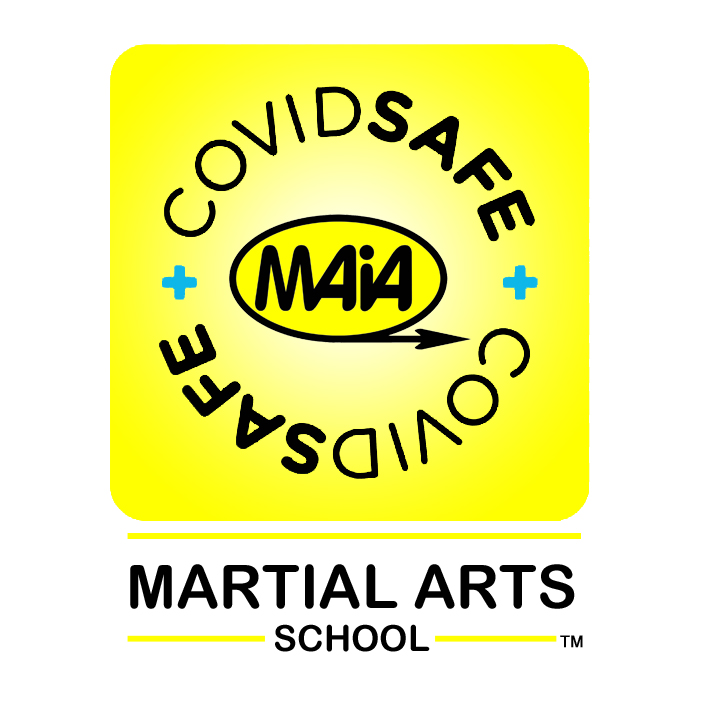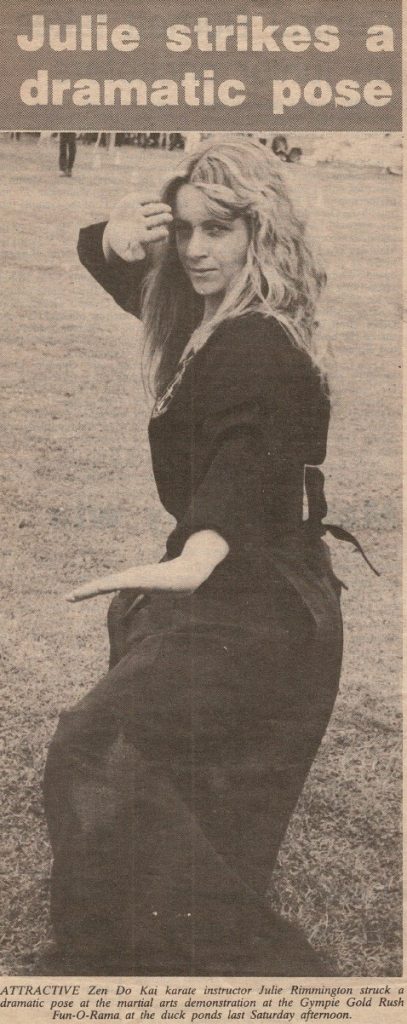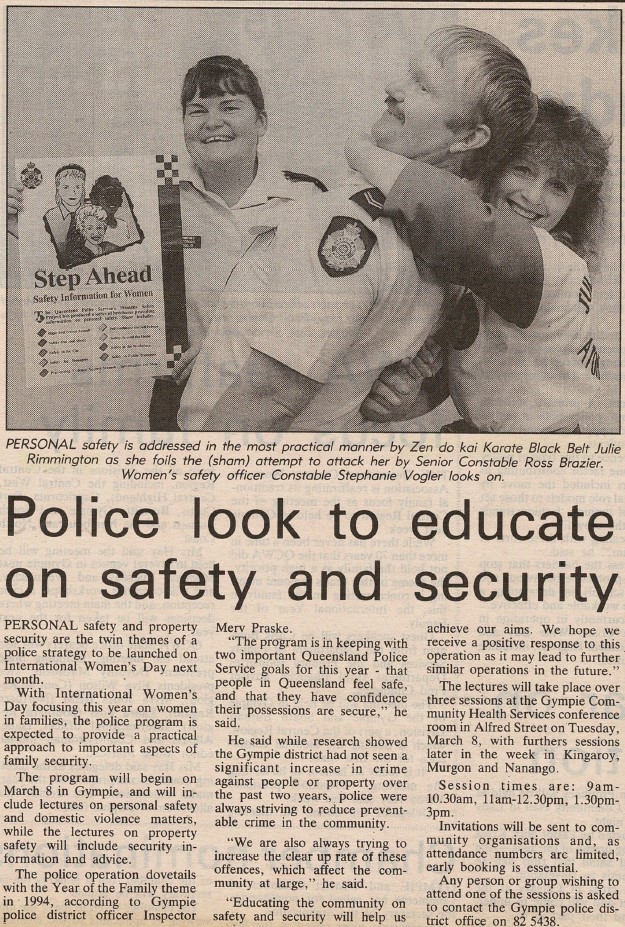History of Karate in Gympie
Gympie has a rich history of martial arts. In the beginning there were tense rivalries, conflict and hard old school training. Incredibly, these rivalries served to promote an explosion of physical prowess. They also heightened levels of martial arts skills and sheer determination and will.
Trevor and Julie Rimmington arrived in Gympie in the year 1980. They were already keenly learning the freestyle martial art Zen Do Kai. Previously they trained since the year 1974 in Alexandra Headlands. They had already developed a passion for the martial arts. In those early years there was no freestyle club for karate in Gympie. Therefore in order to learn more they traveled to the Sunshine Coast and Brisbane to further their skill-set.
By 1981 Trevor and Julie had opened their first martial arts school in Imbil. Soon after they relocated to their new hometown of Gympie. Fortunately, they were not the only people with a passion for martial arts in Gympie. In those early days, Gympie had a Sugi Dojo club, a Golden Fist Club, a Judo Club, a boxing club. Over the years some clubs closed and others opened. The Judo club closed down; the boxing club closed down only to have others open in their place a few years later. Some clubs changed their name while new, unheard of clubs popped up on nearly every street corner.
Early 80’s Karate in Gympie welcomes Inter style tournaments
Why didn’t clubs want to compete with other clubs?
In these very early days, some clubs conducted in-house tournaments. These tournaments were against other clubs studying the same type of Martial Arts as them. Perhaps this fear of branching out was because instructors didn’t want to put themselves on the line. Similarly, they fiercely protected the reputation of their karate style. Therefore, what would happen if they lost? Would they look weak? Were they afraid students would jump ship to the club that ultimately won the tournament?
Perhaps none of these was the real reason for choosing not to compete. Each martial arts club teaches different techniques to other styles. For instance, some use leg kicks while others deem this an illegal technique. Some punch to the face while others do not allow this. Some Dojoj teach grappling and it is tabu in others. These differences made it incredibly difficult to decide upon a set of rules. As these rules would have to be safe and yet fair to all competitors.
Golden Fist conducted first inter-style tournament
Golden Fist was the first Karate in Gympie to invite every different style of Martial Arts to compete against each other. Consequently it was the beginning of an era. Invitations extended throughout the Sunshine and Cooloola Coast regions. Unfortunately, only a handful of clubs chose to compete. The Rimmington’s clubs were among those who competed and thoroughly enjoyed the challenge. Rules in these initial inter-club tournaments proved difficult for some clubs to abide by. This was mainly because the level of contact allowed was less than the level they were accustomed to training with. This in turn led to some clubs suffering numerous losses as a result of disqualification. Still, competitors had the time of their lives. They loved competing against new faces and different styles using different techniques. The only events offered were sparring and kata though.
1983 Amamoor regional karate camps
Cooloola played host to camps isolated to style learning which was common in those years. The Rimmingtons conducted these camps free of charge in the Amamoor State Forestry. These made good use of the campgrounds at Cedar Grove. Clubs from throughout the Cooloola region attended. Because Karate in Gympie was so strong, the training camps were located close to this area.
The training was old school and hard. Long training runs through the bush tracks started the training off at daylight. After breakfast around a campfire, training continued with bag work, focus pad work, sparring and kata. Karate in Gympie also introduced Kendo around this time.
Karate students attended these camps with their families and partners, all enjoying the great outdoors. To elaborate, bushwalks, native fauna and a beautiful freshwater swimming hole made hours of fun for families and students between training sessions.
Most importantly though, this era formed the very foundations of the Rimmington Martial Arts “Family”. The level of encouragement and support for each other within the club was enormous, the bond unbreakable.
The release of the KARATE KID movie in 1984 brought a surge of new students to all dojos. Kids around the country were standing on one leg in their lounge rooms, arms in the air, asking to learn karate. To explain, they were all looking to emulate the fighting techniques seen in the movie. Consequently this created a huge boost to interest in karate in Gympie.
1984: Karate kid boost to Karate in Gympie
As a result, from a predominantly adult membership base, clubs suddenly found themselves inundated with junior students. Many dojos refused to teach juniors whereas others agreed but with strict entry age requirements. The infinite benefits of martial arts for kids had not yet become common knowledge throughout the community.
1984 Kickboxing Lands in Gympie
Martial Arts in Gympie responsible for the birth of Kickboxing
In the early 80s kickboxing was becoming quite popular in America. Trevor and Julie Rimmington together with Roger Hilton from the Sunshine Coast jumped right on board. That is to say they were so enthusiastic about the new sport, they could not wait to be involved. In no time at all, they were training fighters. Furthermore they bought themselves a boxing ring and gloves and were ready to start promoting fight shows. Together, Mr & Mrs Rimmington and Roger Hilton conducted the first kickboxing shows on the Sunshine Coast. Furthermore they promoted the very first kickboxing shows in Gympie as well. Later Joe Hilton also began to train fighters on the Sunshine Coast.
Australian Rules Kickboxing
From meagre beginnings, Kickboxing’s evolution in Australia is incredibly interesting. However, the first shows in Australia were quite different to those drawing crowds in the U.S. Australian officials deemed that kicks to the legs were too brutal and unsportsmanlike. Therefore they could not be legal in Australian sport. Consequently, we started out training fighters and promoting shows under “Kickboxing- Australian Rules”.
Rules: Australian rules kickboxing
Under these rules, two fighters fought in a square ring with one referee officiating. Fighters consisted of karate enthusiasts looking for more excitement and “contact”. Due to their Martial Arts origins, fighters wore long karate pants and were bare chested. Compulsory safety gear included mouth guards, groin guards, boxing gloves and soft padded boots to lessen damage from kicks. With this in mind, fighters could score points by punching or kicking to the head or torso. Leg kicks were not allowed and clinching was illegal. Each fighter was required to score eight kicks above the waist in every round. Failure to do so resulted in losing one point for every kick less than the required eight.
Three judges sat on different sides of the ring to score the fight. Beside two of the judges sat a “kick-counter”. His responsibility was to count the number of kicks scored above the waist in each round.
Initially fight shows started out at the Yandina Sports Club and Nambour Show Pavilion. As popularity soared, the shows moved to the Mooloolaba Hotel and later the Ettamogah Pub. Gympie’s very first Kickboxing Shows were held at the Gympie Civic Centre and Freemason’s Hotel. Fighters came from further afar and eventually came from overseas to compete. Gympie fighters trained by the Rimmingtons have been privileged to win dozens of titles, from Regional through to National Titles.
American Rules Kickboxing
After a few years of Kickboxing increasing in popularity, the Australian population was somewhat desensitized to kickboxing as a sport. As a result the American Rules of Kickboxing were adopted and made legal in Australia.
Karobics – 1984 The fitness revolution
In the early eighties the fitness revolution had exploded in the U.S.A. and Australia immediately followed the trend. Lycra leotards and leg warmers were the fashion of the day. At the same time, by 1984 Julie Rimmington had opened a chain of “KAROBICS” classes. They spanned towns within a 150km radius of Gympie.
Karobics was a combination of karate, boxing, dance and other fitness disciplines done to high-energy music. Instructors choreographed classes like an aerobics class but the movements were more like a martial arts class. Similarly, dress code was every bit as colourful, tight and shiny as an aerobics class.
Some years later, gyms were seeing the introduction of Les Mills Combat workouts. At the same time Billy Blanks was selling Tae Bo videos in stores around the world. The eighties was certainly the “workout” decade if not the weird fashion decade.
1984 Gold Rush Festival
The community culture so strong in the Rimmington dojos spilled over into the Gympie community as well. Not only did the club members support each other, they supported the local communities around their homes also. The club performed demonstrations for school fetes and for the Gympie Show Society. Additionally the supported Gympie’s Gold Rush Festival each year in October.
“Gympie’s Gold Rush Festival is a celebration of our history. Gympie in known as ‘the town that saved Queensland from bankruptcy’ when James Nash first discovered gold back in 1867. The festival from 18-20 October, will include a Gold Rush Parade, Gold Rush Carnival, and a community picnic day.”
Martial Arts in Gympie hits the streets
Rimmingtons Dojos from Gympie and surrounding areas teamed together to prepare a float. This float entered into the annual parades and the club performed demonstrations at the carnivals afterwards. Specifically, a truck donned two 8 metre hand-painted dragons up each side and carried a boxing ring on the back. Fighters provided the crowds lining the streets with demonstration bouts. Meanwhile students marching behind the truck stopped to entertain the crowds with demonstrations in the street. In addition, two huge horses wore full ancient battle attire. They carried riders wearing full Kendo suits of armour.
Those were the days of intense rivalry between different martial arts styles. So much so, that rival martial arts clubs positioned members on the roofs and balconies lining the streets. Not surprisingly they threw water bombs and heckled “opposing” clubs marching in the parade. This kind of behaviour served as an inspiration to train harder, be tougher and strive to always be the best. It also proved entertaining and lots of fun.
https://www.gympie.qld.gov.au/goldrush
1985 Self-Defence – Protecting Gympie’s most vulnerable
By the mid eighties Rimmington clubs were performing demonstrations for community events. At the same time they provided free self-defence lessons for the Gympie and surrounding regions. Together these activities kept the club busy almost every weekend.
Thereupon Julie Rimmington was the go-to expert for women’s self-defence courses and lectures. She provided free self-defence sessions and information to a number of organizations. Examples include Gympie’s Women’s Crisis Centre, the Sunshine Coast Rape Crisis Centre and for the regional Police Department.
In addition, International Women’s Day saw Mrs Rimmington teaming up with local Police Officers and Clergy. Together they provided “Women’s Safety” seminars throughout the entire week in March. Seminars rocked in numerous towns and cities across Gympie South Burnett regions. The Police Officers spoke about home safety and safety in the car. Meanwhile Mrs Rimmington gave advice and demonstrations of techniques and strategies for personal safety.
Muay Thai strikes hard in Gympie 1989
Self-defence courses were conducted by the Rimmington team in primary and high schools. These taught karate in Gympie and surrounding districts. The team even attended retirement homes and senior citizens meetings to empower the elderly to protect themselves. An underpinning philosophy of Rimmington Dojos is “Everyone has the right to feel safe”.
By 1989, Muay Thai had become the “next big thing” throughout world of fighting arts. Consequently, Mr Hilton and the Rimmingtons were quick off the mark to embrace the concept.
Muay Thai is the national sport of Thailand. As such, it is a cultural martial art. In addition to “Thai Boxing”, Muay Thai often is referred to as “The Art of Eight Limbs” . Fists elbows and knees are used for striking. Meanwhile, forearms and shins toughen up through deliberate training methods to act as armour, defending against blows. Clinching and spinning the opponent serves to drive the opponent to the ground to potentiate “the kill” (historically speaking).
It goes without saying that this increase in the level of contact added to the popularity of shows around the world. The fight shows grew in size and frequency as the number of fighters and spectators increased.
The “Blood Shed”
Rimmington Martial Arts in Gympie were right on board with the Muay Thai revolution. To this end they established a permanent training centre for kickboxing and Muay Fighters. The shed was purpose built, fitted out with all the necessary equipment to train fighters. For instance, there was a full sized ring, mats, hanging bags, weights and focus pads. As such, it was the perfect venue for some of the hardest training sessions imaginable. Consequently it carried the name “The Blood Shed”, affectionately of course.
In following years Muay Thai clubs, or stables as they were called, came and went. They opened and closed. Few of the original pioneers are still involved in training fighters or promoting fight shows. One such legend though is Joe Hilton. Previously, Joe began to train fighters and run fight shows not long after his brother Roger and the Rimmingtons. Joe is still a legend in the muay thai world to this day. That is to say he is still promoting fight shows. In addition he still operates an extremely successful Thai Boxing Centre on the Sunshine Coast. Joe is responsible for training dozens of World Champions both male and female, junior and senior.
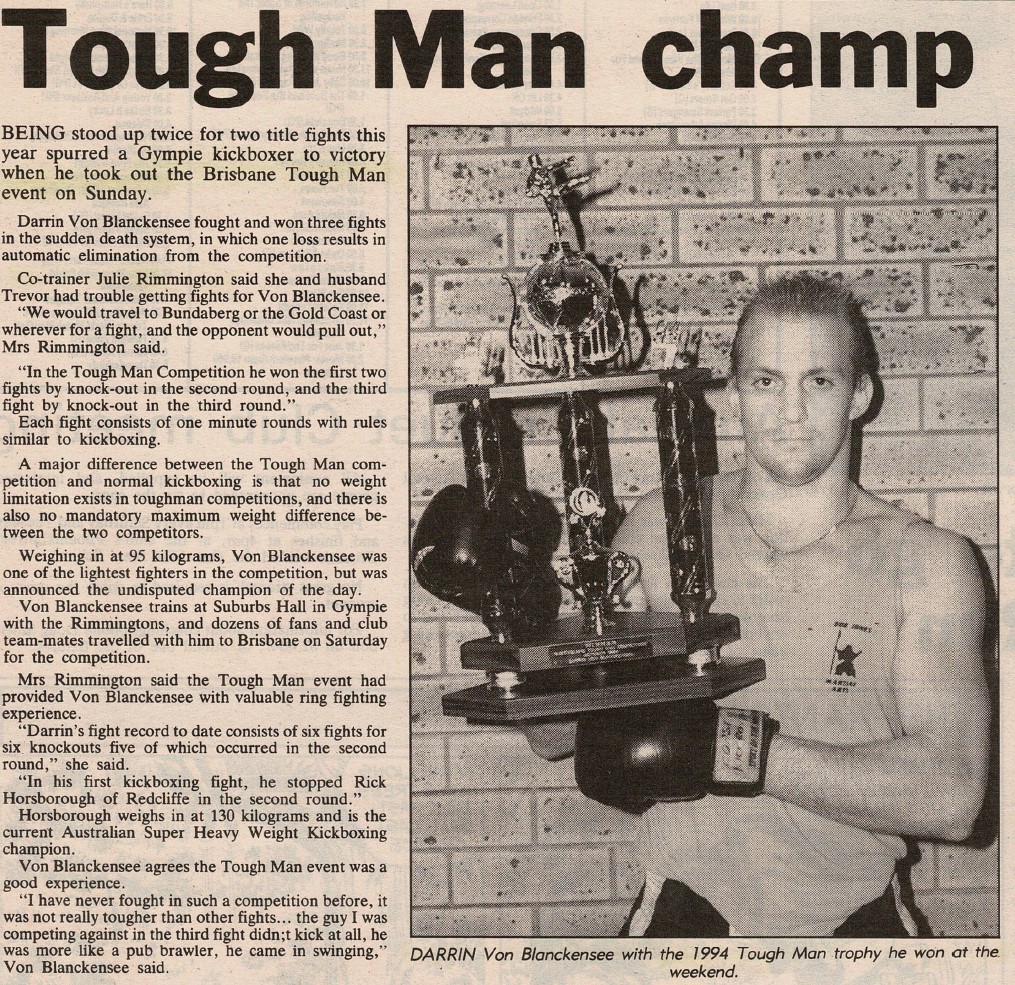
1994 Gympie Times – Self-defence Articles
In 1994, the Year of the Family, personal safety was a hot topic throughout the community. Rimmington karate in Gympie was invited by the local newspaper to offer general advice to the public on topics relating to personal safety. Julie Rimmington wrote a series of articles for the Gympie Times giving advice and strategies on self-defence. The importance of prevention was a prime emphasis, as was environmental awareness. The articles also featured ways to “even the odds” if attacked by a larger or stronger assailant. The articles were so well received that a series of self-defence courses were delivered to the numerous people who asked for practical lessons.
1995: Police and Martial Arts in Gympie team up to help youths
G.I.R.L.S. Program
In 1995, Rimmington Martial Arts and karate in Gympie teamed with Gympie’s Positive Policing officer, Constable Stephanie Voglar to assist “at risk” teens in the Gympie region. Thereupon Julie Rimmington and Constable Voglar developed the G.I.R.L.S. PROGRAM. G.I.R.L.S. stands for:
Goals we set are goals we get. Increasing my potential. Respecting myself and others. Living & loving my life. Seeing self as Special
The target group consisted of girls between the ages 14-16 who were currently being counselled through their respective school counsellors, but have not come into contact with the justice system.
The major aims of the project was to build self-esteem within participants, instil positive outlooks, learn self-defence and how better to deal with conflict. Subsequently the programs were extremely successful, with documented significant improvements in self-confidence, outlook and behaviour. Hence, annual programs were conducted for the next few years.
Camps 1995
By 1995, explosions in camp numbers and growing popularity meant the camps had outgrown local Gympie venues. In other words Gympie was unsuitable to host events of this magnitude. Most importantly though this success signaled the dawn of an acceptance and embracing of other styles. Furthermore it lead to major strengths and an openness to share and exchange knowledge.
From those days of pitching tents in the Amamoor State Forest or Borumba Dam, the Rimmingtons needed to expand their horizons. They were determined to continue to offer more opportunities to learn and progress. The camps moved to recreational venues offering accommodation. Venues like the Sunshine Coast Recreation Centre at Currimundi, Maroochy Waterfront Camp and Conference Centre and the Alexandra Headlands Youth Camp (now called Alexandra Park Conference Centre) were now used on a regular basis.
Martial Arts enthusiasts in the hundreds came together from all over Queensland and New South Wales. These super keen martial artists united to share ideas and training methods. In addition, they relished in the opportunity to train with and test their abilities against new and different martial artists.
These enthusiasts came from a variety of different forms of Martial Arts. Some were strictly Muay Thai in origin, some were traditional karate, some were Jiu Jitsu and grappling and others were from clubs who practised a mixture of many styles of Martial Arts. The students gained great insight into the extensive realm of diverse techniques, strategies and philosophies that make up the Martial Arts.
Exploring different aspects of Martial Arts
Athletes were offered the opportunity to try Martial Arts styles completely foreign to the style they may have been solely training in. Grapplers were able to try out some Muay Thai, Kickboxers were able to learn some weaponry, and traditional Karate students were able to learn some BJJ. In addition, students from Freestyle clubs were able to concentrate on and sharpen the finer details of techniques by training with specialist instructors in the various fields.
World-Class Instructors
These nationally and world-renowned instructors came from throughout Australia and overseas to share their knowledge and training with those on camp. Celebrities such as movie star Richard Norton, International karate champion and author Patrick McCarthy, founder of Zen Do Kai Bob Jones, Senior BJJ Black Belt instructor John Will and dozens of others joined to instruct the many sessions.
The Rimmingtons ensured each camp had a different group of instructors so students were continually stimulated, learning new things all the time. Sessions varied with each camp also. Most camps gave students a choice of training sessions to attend for each allotted time-slot. They were “spoiled for choice”.
These training sessions covered a broad range of branches of Martial Arts, from traditional to very modern. More traditional sessions focused on the areas of kata, kata interpretation, traditional judo, boxing and weaponry. Newer (to Australia) concepts included training in Muay Thai, BJJ and MMA. Content covered in these camps was simply overwhelming.
In the weaponry department alone, there was enough content to keep most students practising from one camp through to the next without ever perfecting the larger percentage of what they had been shown. The weapons learned ranged from Nunchaku, tonfa, katana and Bo/Staff to kendo, Sai Swords and Escrima Kali.
Positive Energy
With such a variety of sessions on offer, anticipation and enthusiasm was always high. Positive energy consumed the camp-grounds and bounced from one camper to the next. There were no enemies, just fellow martial artists forming new friendships and creating networks for learning into the future.
BJJ 1999
Coming soon
2000 Rimmington Martial Arts and karate in Gympie opens full-time studio
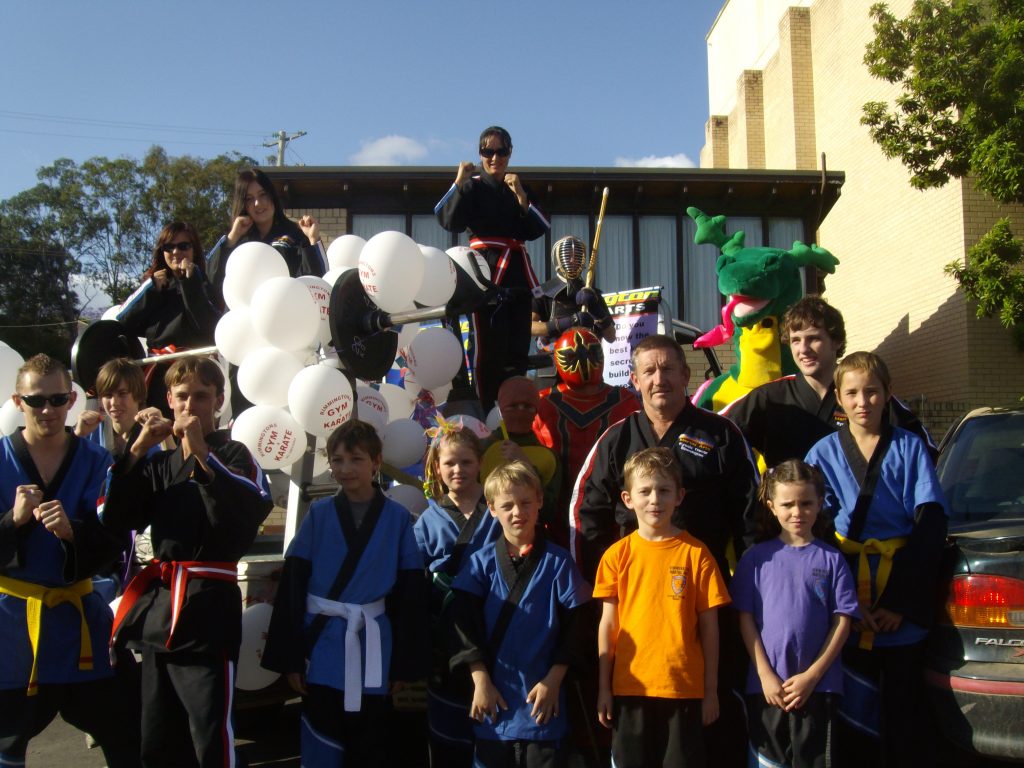
Coming soon
Need more information on kids karate?
